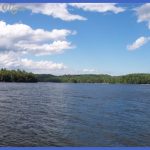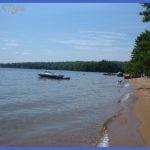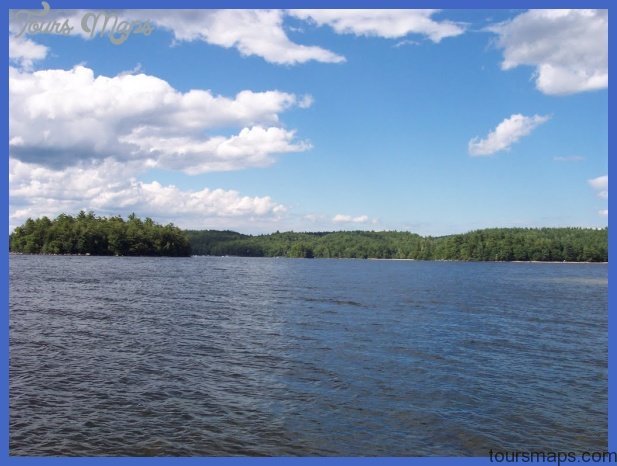Key Species: lake trout, brook trout, landlocked salmon, brown trout possible, smallmouth bass, largemouth bass, white perch, black crappie, pickerel, cusk
Best Way to Fish: boat, canoe
Best Time to Fish: late April through September
MAG: 5, C-1
Description: Second in size only to Moosehead Lake, 28,771-acre Sebago Lake is an amazing 316 feet deep. This lake is one of the original homes of the landlocked salmon, Salmo sebago.
Fishing is a popular industry in the Sebago region. Motels, marinas, and tackle shops abound. Although small boats and canoes are useful in sheltered areas and near the shore, you really need a boat of 16 feet or more if you plan to visit any of the offshore areas. Sebago Lake is nearly round, and this open aspect is conducive to potentially dangerous high winds, which can whip the lake to a froth.
Sebago Lake is situated in a built-up part of Maine, but its large size ensures plenty of room for all. Some limited fishing can be done from shore at Sebago Lake State Park, but you really need a boat or canoe in order to take full advantage of the lake’s resources. The park offers campsites as well as two boat ramps. Another public boat ramp is located off U.S. Route 302 in the town of Raymond, at the north end of Jordan Bay. Motels can be found along U.S. Route 302 between North Windham and Portland.
Fishing index: As soon as the ice melts, usually in mid or late April, hundreds of boats descend upon Sebago. Landlocked salmon are the main target for these early-season anglers. Sebago Lake has a large number of lake trout, and liberal bag limits have been imposed. Lake trout are especially active in the early season. The near-surface action continues through May and June and can even last into July during years with a late spring. Later on in the summer, anglers turn to deep-trolling methods for salmon and lake trout. Dodgers, fished with downriggers, are the usual fare for summertime trolling. Popular spots for landlocked salmon include: the mouth of the Songo River, the mouth of Northwest River and north to the mouth of Muddy River, and the mouth of Jordan Bay. Lake trout will be found here too, but in deeper water. You can get results by drift fishing large minnows on the bottom in the deep holes on the east side of Spider Island. Brook trout are found near the river mouths and close to the shore and can be taken by slowly trolling a night crawler behind a small spinner.
Sebago Lake has immense potential for warmwater species, a fact most trout and salmon anglers tend to dismiss. Try the Dingley Islands, the north end of Spider Island, and the shoreline around Raymond Neck for smallmouth bass. Try fly-rod poppers on calm days.
Use a 6-weight rod and weight forward line. Muddler minnows are effective underwater imitations. Use a sinking fly line and slowly twitch the fly while you retrieve it. Effective spinning lures for smallmouths include Mepps spinners, 6-inch plastic worms in black and purple, and plastic-bodied lead-head jigs. Jig bodies with glitter tails are especially good. Ultralight spinning rods loaded with 4-pound test line are
A pair of ducks swims near the sandy shoreline at Sebago Lake State Park. The lake s slightly choppy in this photo, perfect for trolling for landlocked salmon. perfect for feisty smallmouths. For largemouth bass, crappies, yellow perch, and pickerel, try the north end of Jordan Bay, the shallows between Dingley Islands and Kettle Cove, and the Sticky River basin. Largemouth anglers do well in the early morning and evening with poppers, and daytime anglers prefer plastic worms of 6 inches and larger. Use a medium-weight spinning rod or bait-casting rod for largemouths. Use at least 6-pound test line. Eight-pound test is better because Sebago can produce some huge largemouths. Bait fishers should use nightcrawlers or large golden shiners. Pickerel anglers should stick to the shallows. Try small Daredevle spoons and spinners with yellow hackle on the treble hooks. Yellow streamer flies and bucktails are also good pickerel lures, since pickerel feed voraciously on yellow perch. Anglers seeking yellow perch and crappies should fish in about 20 feet of water, using worms, small shiners, and small twister-tail jigs. A fish locator is a great help in locating schools of crappie and yellow perch.
Directions: From North Windham, head northwest on U.S. Route 302 to Casco. In Casco, look for a sign on the left for Sebago Lake State Park.
For more information: Contact Sebago Lake Marina.
Sebago Lake Photo Gallery
Maybe You Like Them Too
- The Best Cities To Visit in The World
- World’s 10 Best Places To Visit
- Coolest Countries in the World to Visit
- Travel to Santorini, Greece
- Map of Barbados – Holiday in Barbados




